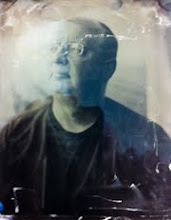Title: "Abandon all hope of knowledge"
(click image to view larger)
I went over to the library on campus today to get the 1983, expanded version of Helen Levitt's book of photographs, "A Way of Seeing". Levitt's lyrical photographs of New York street scenes made in the 1940s is absolutely captivating - the way children play, the random interactions of people on the streets look staged only because it is rare to see anything like this today. It's absolutely fascinating to see these images of children playing on their own, with make-shift costumes and toys, joining in games that are invented on the spot. There is such a spirit of inventiveness and imagination that is probably quite foreign to most of today's children with their organized play dates, soccer/dance/music lessons and demand for sophisticated tools of play (7 year olds with laptops?).
James Agee wrote a wonderful introductory essay to Levitt's work in 1946, and one of the passages really hit home with me regarding the problem artists (everyone) have with the visual assault we experience on a daily basis. In writing about the potential reasons why few photographers engaged in making street, or lyrical photographs Agee offered a few possibilities. "...it has become all but impossible, even for those who had it in the first place, to maintain intact and uncomplicated the simple liveliness of soul and of talent without which true lyrical work cannot be done. As small, quick, foolproof cameras became generally available, moreover, the camera has been used so much and so flabbily by so many people that it has acted as a sort of contraceptive on the ability to see. And more recently....the camera has been used professionally, a hundred times to one, in ways which could only condition and freeze the visual standards of a great majority of people at a relatively low grade...photographers who really have eyes, and who dare to call their eyes their own, and who do not care to modify them towards this standardized, acceptable style, have found it virtually impossible to get their work before most of those who might enjoy it..."
In many ways, what Agee wrote in 1946 nicely summarizes my on-going love/hate relationship with sites like Flickr. The vast majority of images one is exposed to on Flickr can truly act as a "contraceptive on the ability to see" and tend to freeze community visual standards at a "relatively low grade". However with some serious effort, Flickr does also offer those "who dare to call their eyes their own" a way to get their work before others who can appreciate and enjoy it. I have finally come to a personal way of using Flickr to get my work before a relatively small, select group of people whose work I respect, whose assessments of my own work I value and trust, and who do not simply constitute a mutual admiration society. Still, at the end of the day, I think the balance of time must be spent on doing one's work in response to the internal guide, as the surest way to avoid modifying one's eyes towards some standardized, acceptable style.


1 comment:
I absolutely agree that the internal guide is truly precious, the source of each artist's uniqueness.
Post a Comment